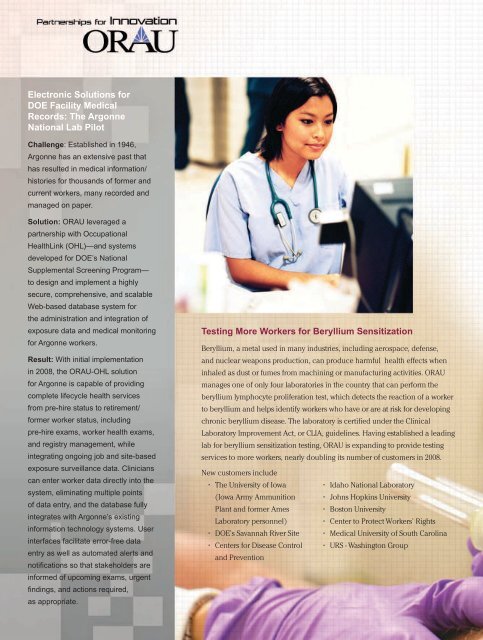2008 ORAU Annual Report - Oak Ridge Associated Universities
2008 ORAU Annual Report - Oak Ridge Associated Universities
2008 ORAU Annual Report - Oak Ridge Associated Universities
You also want an ePaper? Increase the reach of your titles
YUMPU automatically turns print PDFs into web optimized ePapers that Google loves.
29<br />
Worker Health and Electronic<br />
Medical Records Management<br />
Electronic Solutions for<br />
DOE Facility Medical<br />
Records: The Argonne<br />
National Lab Pilot<br />
Challenge: Established in 1946,<br />
Argonne has an extensive past that<br />
has resulted in medical information/<br />
histories for thousands of former and<br />
current workers, many recorded and<br />
managed on paper.<br />
Solution: <strong>ORAU</strong> leveraged a<br />
partnership with Occupational<br />
HealthLink (OHL)—and systems<br />
developed for DOE’s National<br />
Supplemental Screening Program—<br />
to design and implement a highly<br />
secure, comprehensive, and scalable<br />
Web-based database system for<br />
the administration and integration of<br />
exposure data and medical monitoring<br />
for Argonne workers.<br />
Result: With initial implementation<br />
in <strong>2008</strong>, the <strong>ORAU</strong>-OHL solution<br />
for Argonne is capable of providing<br />
complete lifecycle health services<br />
from pre-hire status to retirement/<br />
former worker status, including<br />
pre-hire exams, worker health exams,<br />
and registry management, while<br />
integrating ongoing job and site-based<br />
exposure surveillance data. Clinicians<br />
can enter worker data directly into the<br />
system, eliminating multiple points<br />
of data entry, and the database fully<br />
integrates with Argonne’s existing<br />
information technology systems. User<br />
interfaces facilitate error-free data<br />
entry as well as automated alerts and<br />
notifications so that stakeholders are<br />
Testing More Workers for Beryllium Sensitization<br />
Beryllium, a metal used in many industries, including aerospace, defense,<br />
and nuclear weapons production, can produce harmful health effects when<br />
inhaled as dust or fumes from machining or manufacturing activities. <strong>ORAU</strong><br />
manages one of only four laboratories in the country that can perform the<br />
beryllium lymphocyte proliferation test, which detects the reaction of a worker<br />
to beryllium and helps identify workers who have or are at risk for developing<br />
chronic beryllium disease. The laboratory is certified under the Clinical<br />
Laboratory Improvement Act, or CLIA, guidelines. Having established a leading<br />
lab for beryllium sensitization testing, <strong>ORAU</strong> is expanding to provide testing<br />
services to more workers, nearly doubling its number of customers in <strong>2008</strong>.<br />
New customers include<br />
• The University of Iowa • Idaho National Laboratory<br />
(Iowa Army Ammunition • Johns Hopkins University<br />
Plant and former Ames • Boston University<br />
Laboratory personnel) • Center to Protect Workers’ Rights<br />
• DOE’s Savannah River Site • Medical University of South Carolina<br />
• Centers for Disease Control • URS - Washington Group<br />
and Prevention<br />
Documenting the Dose Reconstruction Process<br />
<strong>ORAU</strong> and its partners, Dade Moeller & Associates and MJW<br />
Corporation, as well as personnel from NIOSH, contributed 16<br />
papers documenting the EEOICPA dose reconstruction process to<br />
a special issue of Health Physics: The Radiation Safety Journal, July<br />
<strong>2008</strong>, the main publication of the Health Physics Society.<br />
The papers provided an in-depth review of the collection,<br />
processing, and management of the required data; the assessment<br />
methods used; the scientific basis for the assessments; and<br />
the prominent roles of the health physics and radiation safety<br />
professionals in the effort. In addition, this collection of papers<br />
serves as the only volume that assembles in one place all the key<br />
issues about the scientific aspects of the NIOSH dose reconstruction<br />
process and the worker compensation program. Since 2002,<br />
the <strong>ORAU</strong> Team has performed 21,678 initial, individual dose<br />
reconstructions as part of a contract with NIOSH.<br />
Radiation dose<br />
reconstruction is…<br />
the process of estimating the radiation<br />
exposures received during the course<br />
of a person’s work. In turn, the<br />
reconstructed dose is used to determine<br />
the probability of whether a worker who<br />
has cancer actually developed it as a<br />
result of the radiation dose.<br />
The process is required under the<br />
Energy Employees Occupational<br />
Illness Compensation Program Act<br />
(EEOICPA) for compensation claims<br />
submitted by nuclear-weapons-related<br />
workers (or their families) for DOE or its<br />
predecessor agencies.<br />
In FY08, <strong>ORAU</strong>’s Beryllium Laboratory<br />
nearly doubled its number of customers<br />
and performed a total of 3,464 beryllium<br />
lymphocyte proliferation tests with only a<br />
0.2% error rate.<br />
informed of upcoming exams, urgent<br />
findings, and actions required,<br />
as appropriate.

















